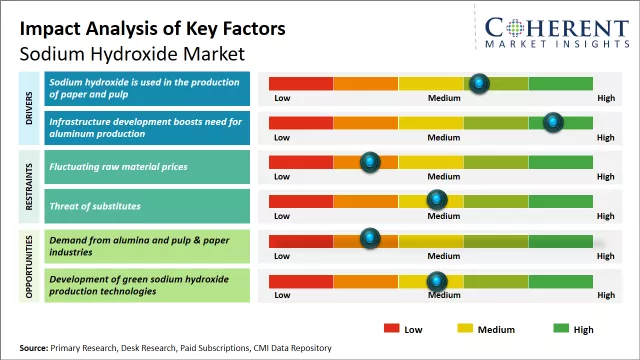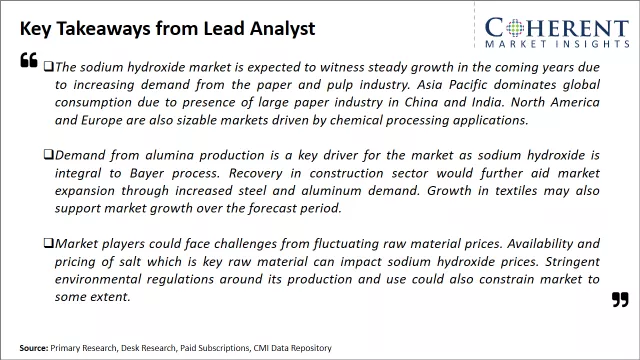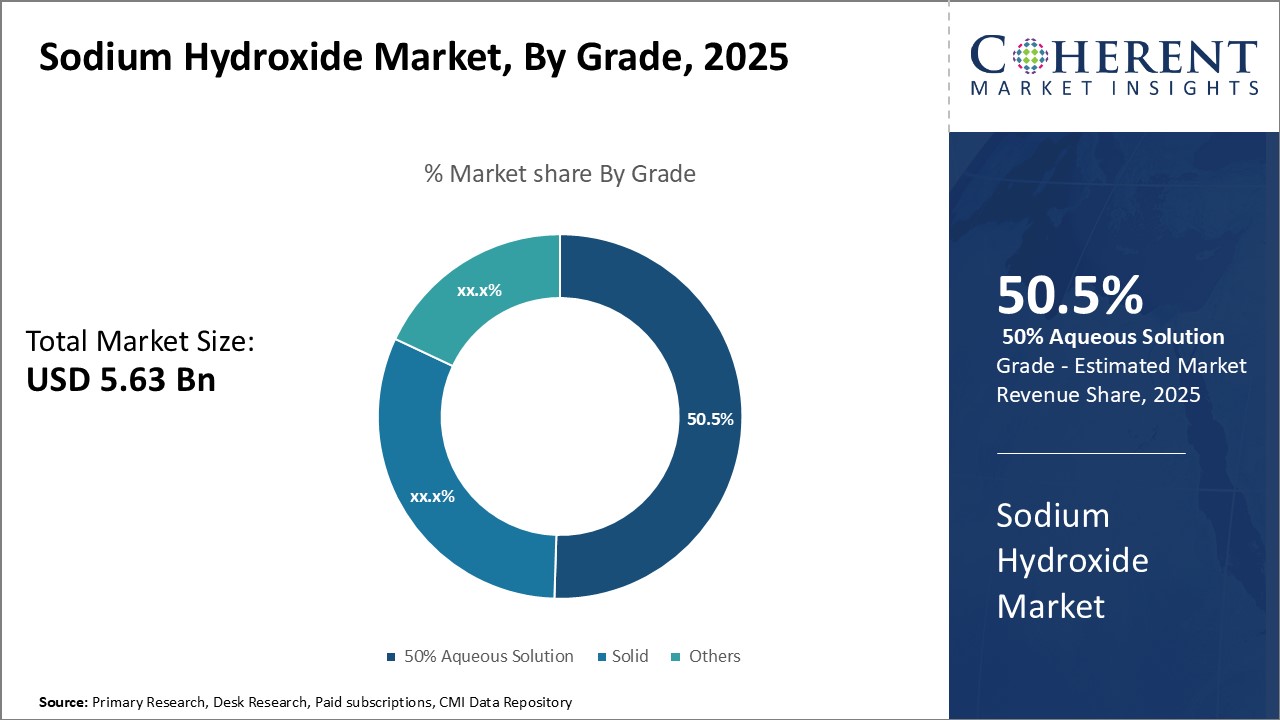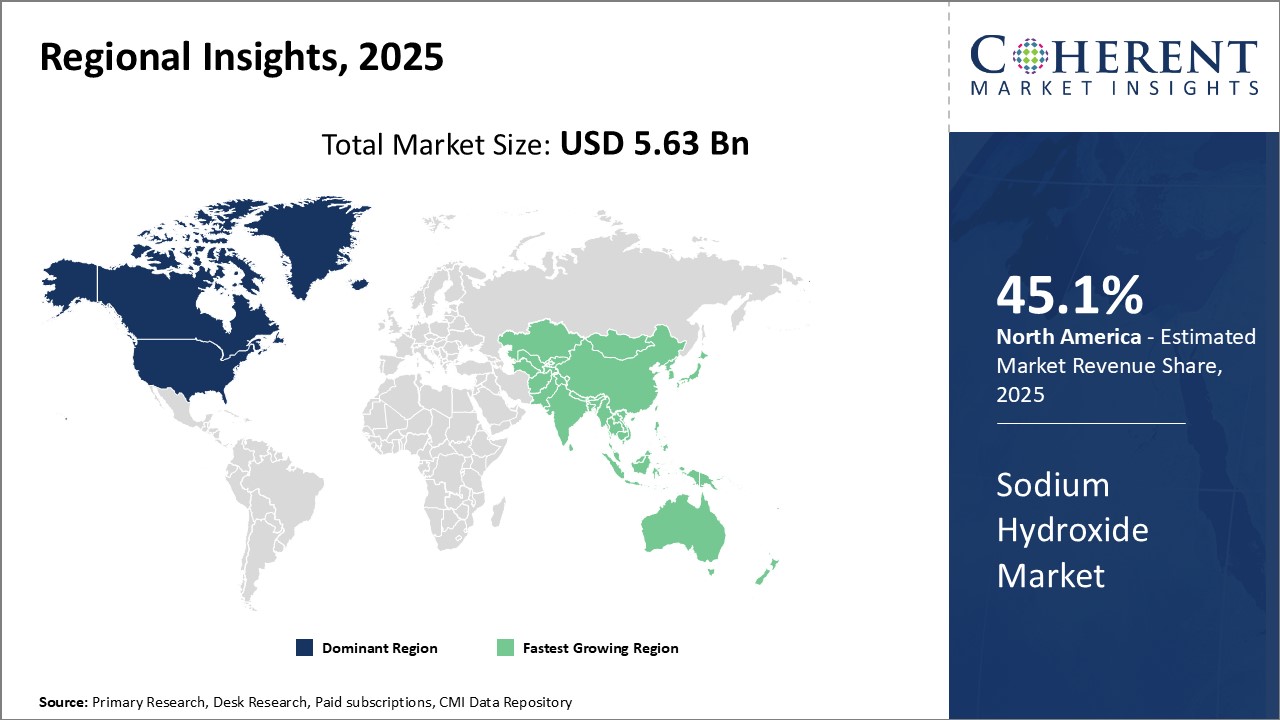The sodium hydroxide market is estimated to be valued at USD 5.63 Bn in 2025 and is expected to reach USD 7.72 Bn by 2032, growing at a compound annual growth rate (CAGR) of 4.6% from 2025 to 2032.

Discover market dynamics shaping the industry: Request sample copy
Sodium hydroxide, also known as lye or caustic soda, has widespread applications in industries like alumina, textiles, pulp & paper, soap & detergents, and petroleum products among others. Its demand is projected to increase with rapid industrialization and economic growth in various regions across the globe. The market is expected to witness fruitful opportunities and maintain a steady growth trend during the forecast period. Rising demand from end-use industries like paper & pulp and alumina along with growth in other industries will drive the sodium hydroxide market growth during this period. Additionally, increasing investment in infrastructure development and focus on renewable energy in different regions will also contribute to the growth of the sodium hydroxide market. However, availability of substitutes and fluctuating raw material prices may hamper the market growth.
Sodium hydroxide is used in the production of paper and pulp
One of the major drivers propelling the growth of the sodium hydroxide market is the rise in paper production across the globe. For instance, according to data published by the Vietnam Pulp and Paper Association (VPPA) in 2021, the consumption of paper for packaging in Vietnam in May 2021 was 404,711 metric tons, an all-time high. The domestic paper industry has witnessed positive growth over the last five years (2015–2020), and it is expected to grow continuously over the forecast period. Thus, increasing paper production to meet the growing demand from the packaging sector and capacity expansion of paper production mills are expected to drive demand over the forecast period. Sodium hydroxide, commonly known as caustic soda, is one of the key ingredients used in the manufacturing process of paper. It acts as a bleaching agent that removes remaining lignin from the pulp to give paper its characteristic whiteness. With economies worldwide witnessing a boom in digitalization, the demand for all types of paper such as copier paper, cardboard, newsprint and tissue paper is growing steadily. The e-commerce revolution has led to a surge in cardboard packaging material being used for product delivery. Meanwhile, tissue papers find widespread application in households as well as commercial establishments like offices and public restrooms. The packaging industry is also augmenting the consumption of boxboard and containerboard. All these end-use sectors are major consumers of virgin and recycled fibers that serve as the raw materials in paper production. With paper consumption rising on the back of expanding digital content and ever-growing e-commerce volumes, the sodium hydroxide demand from the paper and pulp sector continues to rise at a favorable pace. Leading global corporations are heavily investing in setting up new paper mills as well as expanding the capacities of existing units, which will invariably drive more sodium hydroxide consumption going forward.

Get actionable strategies to beat competition: Request sample copy
Infrastructure development boosts need for aluminum productionAccelerating the sodium hydroxide market is the aluminum industry. Sodium hydroxide acts as an essential feedstock material that is used widely in the electrolytic production of primary aluminum. It enhances the conductivity of alumina and allows the metal to be readily dissolved out of the smelting pot. With infrastructure development activities picking up pace globally, fueled by post-pandemic economic recovery programs of various nations, the aluminum demand is surging significantly. Aluminum finds multifold applications as a lightweight, corrosion-resistant, and sustainable construction material used in buildings, vehicles, equipment, and machinery. The boom in residential and commercial construction due to rapid urbanization is propelling aluminum extrusion needs. At the same time, investments in modernizing national infrastructure through projects focused on roadways, railways, urban mass transit, and power grids involve the substantial use of aluminum. Even the renewable energy sector is relying more on aluminum for setting up wind and solar farms.

To learn more about this report, Request sample copy
Market Challenges: Fluctuating raw material pricesThe sodium hydroxide market faces several challenges. Fluctuating raw material prices significantly impact production costs for manufacturers. Additionally, stringent environmental regulations regarding industrial waste water discharge pose compliance issues. Regulatory limits on the transportation of sodium hydroxide also increase operational expenses. Substitute products like caustic potash and slaked lime compete for market share.
Market Opportunities: Demand from alumina and pulp & paper industries
The demand from alumina and pulp & paper industries is expected to grow steadily. Sodium hydroxide finds applications in chemical processing, so expansion in end-use sectors will boost consumption. Adoption of membrane cell technology enables efficiency gains and lowers energy usage in manufacturing. Collaboration with regulatory bodies can help address transportation issues while maintaining safety.

Discover high revenue pocket segments and roadmap to it: Request sample copy
Insights, By Grade: Production Efficiency Drives the Demand for Aqueous Sodium HydroxideIn terms of grade, 50.5% aqueous solution contributes the 67% share of the market owing to its significant production advantages over solid sodium hydroxide. Producing 50% aqueous solution skips the pelletizing or granulation process required for solid sodium hydroxide, allowing manufacturers to achieve higher production volumes in the same plant infrastructure. It also eliminates the energy costs associated with drying and eliminates risks of dust explosion that can occur during powder handling of solid grades. Further, the handling and storage of 50% aqueous solution is safer than anhydrous solid grades due to its fluid state. This reduces safety compliance costs for manufacturers and lowers insurance costs. Its liquid form also makes 50% solution more convenient for customers to transport via pipelines or tankers compared to the hassle of packaging and transporting dry powder or pellets of solid sodium hydroxide.
Insights, By Production Process: Glass contributes the highest share of the market driven by rising construction activities and automotive production
In terms of production process, membrane cell contributes the 43.5% of the market share owing to its significantly higher resource efficiency compared to alternatives like diaphragm cell. Membrane cell technology enables maximizing the concentration of sodium hydroxide in an energy efficient manner using selective ion permeable membranes instead of diaphragms. This allows operating at high current densities while maintaining high electrical efficiency. It eliminates cross-contamination between anolyte and catholyte streams, reducing chemical consumption and waste generation. Further, membrane cells optimize water utilization, reducing freshwater intake by nearly 50% versus diaphragm cells. Their compact modular design is also ideal for fluctuating or seasonal demand profiles as their highly flexible plants can be expanded efficiently. With their benefits of optimized resource and energy utilization, lower environmental impact and flexible design, membrane technology has become the preferred route for most Greenfield and expansion sodium hydroxide projects globally.
Insights, By Application: Cost Considerations Favor Inorganic Chemicals Application
In terms of application, inorganic chemicals contribute 45.5% of the market share owing to sodium hydroxide being extensively used as a key precursor chemical in several lucrative industrial processes. It is a basic raw material for production of sodium carbonate, zeolites, water glass, caustic potash, etc. which are then used to manufacture other in-demand chemicals. Due to its commoditized nature and need in high volumes, inorganic chemical producers are highly cost-sensitive. The pricing advantage of sodium hydroxide over alternative alkalis and its bulk inland availability through production sites, pipelines, and ports suit this price elastic segment. Its liquid storage and handling properties also keep transportation costs low - vital for inorganic chemicals with narrow margins. Sodium hydroxide offers desirable chemical properties for purification, neutralization, and pH adjustment reactions compared to other alkalis. With projected growth in several downstream specialty chemicals, demand from inorganic applications of sodium hydroxide is expected to remain steady in the foreseeable future. The growing chemical industry is expected to drive the market growth. For instance, according to data published by Invest India in 2024, the market size of the chemicals & petrochemicals sector in India is around $ 215 Bn; which is expected to grow to US$ 300 Bn by 2025.

Need a Different Region or Segment? Customize now
North America has established itself as the dominant region in the global sodium hydroxide market with 45.1% of the market share. The region accounts for over 30.5% of the worldwide demand primarily due to the robust presence of key end-use industries such as alumina, pulp and paper, soaps and detergents. The U.S. is the single largest consumer as well as producer of sodium hydroxide globally driving the demand from this region. Major industrial hubs in countries like the U.S. and Canada have significantly aided in the establishment of supply chain network within North America.
The Asia Pacific region is witnessing the fastest growth in the sodium hydroxide market over the recent past. Key factors such as rapid industrialization, growing population, and urbanization have supported the growth of industries that utilize sodium hydroxide. Particularly, the pulp and paper industry is witnessing surge in production volumes across developing economies of China, India, and Indonesia etc. Furthermore, the huge consumption from the alumina and soap and detergent industries has propelled the import volumes to fulfill the supply demand gap. Moreover, due to increasing environmental regulations in developed economies like Japan and South Korea, the end-use industries are shifting their manufacturing bases to developing nations, thus supplementing regional sodium hydroxide consumption. However, with China having a strong industrial manufacturing sector, it contributes the bulk of the Asia Pacific market size supported by strong domestic production capacities. Going forward, rising living standards and expanding middle class population are projected to further stimulate the demand in the near future.
Sodium Hydroxide Market Report Coverage
| Report Coverage | Details | ||
|---|---|---|---|
| Base Year: | 2024 | Market Size in 2025: | USD 5.63 Bn |
| Historical Data for: | 2020 To 2024 | Forecast Period: | 2025 To 2032 |
| Forecast Period 2025 to 2032 CAGR: | 4.6% | 2032 Value Projection: | USD 7.72 Bn |
| Geographies covered: |
|
||
| Segments covered: |
|
||
| Companies covered: |
Dow, DuPont,, Sanmar Group, Gujarat Alkalies and Chemicals Limited, Bayer AG, GACL Ltd., Aditya Birla Chemicals, BSC Chemicals, Tokuyama Corporation., Covestro, BASF, Olin Corporation, Westlake Corporation, Occidental Petroleum Corporation, Xinjiang Zhongtai Chemical Co. Ltd, Akzo Nobel N.V, Brenntag North America, Inc, Vizag chemical, Astrra Chemicals, Vinayak Chemicals, and Ottokemi |
||
| Growth Drivers: |
|
||
| Restraints & Challenges: |
|
||
Uncover macros and micros vetted on 75+ parameters: Get instant access to report
Share
Share
About Author
Vidyesh Swar is a seasoned Consultant with a diverse background in market research and business consulting. With over 6 years of experience, Vidyesh has established a strong reputation for his proficiency in market estimations, supplier landscape analysis, and market share assessments for tailored research solution. Using his deep industry knowledge and analytical skills, he provides valuable insights and strategic recommendations, enabling clients to make informed decisions and navigate complex business landscapes.
Missing comfort of reading report in your local language? Find your preferred language :
Transform your Strategy with Exclusive Trending Reports :
Frequently Asked Questions
Joining thousands of companies around the world committed to making the Excellent Business Solutions.
View All Our Clients
US Reciprocal Tax Impact Analysis On Sodium Hydroxide Market
Stay updated on tariff changes with expert insights and timely information